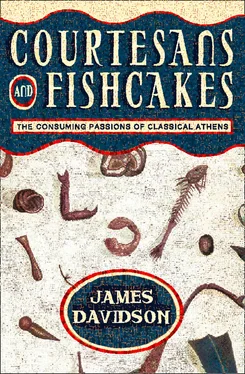Critias’ elaborate defence of the Spartan cup falls into the same apologetic category. This too was a suspicious object. Spartan drinking, without the lively conversation, the toasts and the passing of the cup which characterized well-ordered drinking at Athens, looked rude, ill-mannered and dangerous to Critias’ audience. The Spartan way of drinking from one’s own cup, in silence, bore most resemblance to the transgressive and competitive drinking-to-get-drunk of Choes , the feast of the Pitchers. The cup was itself a symbol for the wrong kind of drinking, as Aristophanes made explicit in his lost play The Banqueters . The play centres on the activities of a man’s two sons, one of them a model of self-control, the other utterly dissipated in every field. An illustration of this dissipation is provided by his drinking habits; no moderate measure for him, no gentle sipping from shallow vessels between anecdotes, but ‘Chian wine from Spartan cups’. 39 Конец ознакомительного фрагмента. Текст предоставлен ООО «ЛитРес». Прочитайте эту книгу целиком, купив полную легальную версию на ЛитРес. Безопасно оплатить книгу можно банковской картой Visa, MasterCard, Maestro, со счета мобильного телефона, с платежного терминала, в салоне МТС или Связной, через PayPal, WebMoney, Яндекс.Деньги, QIWI Кошелек, бонусными картами или другим удобным Вам способом.
The kōthōn , in an Athenian context, far from being an attribute of the rugged asceticism of soldiers, stands for the worst kind of vinous indulgence practised by urban degenerates. The reason for the cup’s infamy seems clear. It was the wrong shape.
The Greeks enjoyed a rich and varied array of cups in all manner of shapes and sizes. There are indications that it was customary to progress from small cups at the start of the symposium to larger ones at the end. The Scythian Anacharsis, who represents for the Greeks something akin to the naive wisdom of the eighteenth-century’s ‘noble savage’, thought this very odd. Why drink from small cups when you’re empty and from big cups when you’re full? At the drinking-party described by Xenophon in his Symposium one of the guests, breathless from an impromptu dancing performance, tries to hurry things along and asks for ‘the big cup’ to quench his thirst. The host concurs and asks for big cups all round; the others are thirsty too, not from dancing but from laughing at his performance. Predictably, however, Socrates, who is a guest at an alarming number of attested symposia, intercedes and speaks in favour of ‘small cups sprinkled frequently, so that we will be seduced into reaching a state of amusement, instead of being forced by the wine into drunkenness’. The moderate drinking practices of the well-ordered symposium call for moderately-sized cups. Drinkers who are getting serious about drinking, on the other hand, typically ask for a big cup, or a bigger cup to show they mean business. The woman in Pherecrates’ Corianno goes so far as to bring her own well-sized vessel along, rejecting the little kyliskē hopefully offered to her. 40 Конец ознакомительного фрагмента. Текст предоставлен ООО «ЛитРес». Прочитайте эту книгу целиком, купив полную легальную версию на ЛитРес. Безопасно оплатить книгу можно банковской картой Visa, MasterCard, Maestro, со счета мобильного телефона, с платежного терминала, в салоне МТС или Связной, через PayPal, WebMoney, Яндекс.Деньги, QIWI Кошелек, бонусными картами или другим удобным Вам способом.
It is important to observe that in the literature big cups are almost always deep cups. The vessels to which they are opposed are flat, shallow, saucerish things. A fragment from a play of Pherecrates makes this relationship between size and shape quite clear. In his play Tyranny , which seems to have been a fantasy of women seizing power on the lines of Aristophanes’ Ecclesiazusae , he describes the women’s control of men’s drinking as follows:
Then for the men they had cups made which were flat, nothing but a base with no sides, and room for not so much as a cockleful, like little ‘tasters’; for their female selves, on the other hand, they had deep cups made, cups like wine-transporting merchantmen, well-rounded, delicate vessels that bulged out in the middle; cups designed with far foresight for maximum consumption and minimal accountability. The result? Whenever we charge them with drinking up the wine they reproach us and swear that they have had no more than a single cup. But this single one is greater than a thousand cups.
A similar contrast is made by Epigenes in his play Heroine: ‘But the potters don’t even make kantharoi nowadays, you poor chap, not those fat ones; they all make these low-lying elegant things instead … as if it were the cups themselves we were drinking rather than the wine.’ 41 Конец ознакомительного фрагмента. Текст предоставлен ООО «ЛитРес». Прочитайте эту книгу целиком, купив полную легальную версию на ЛитРес. Безопасно оплатить книгу можно банковской картой Visa, MasterCard, Maestro, со счета мобильного телефона, с платежного терминала, в салоне МТС или Связной, через PayPal, WebMoney, Яндекс.Деньги, QIWI Кошелек, бонусными картами или другим удобным Вам способом.
The size and shape of the vessels represented a difference in the manner of drinking. Deep cups meant deep drinking, long draughts knocked back from fat vessels, bottoms-up; shallow cups in contrast were drained more elegantly, tilted slightly and sipped frequently between dialectical contributions.
Typical of these vessels of depth was the bat-eared goblet of the Boeotians and Etruscans, the kantharos: ‘Let’s put out into the deep; into the kantharos , boy, pour it, by Zeus, into the kantharos ,’ says a comic character to his slave. A huge kantharos is what gets the nurse drunk in Eubulus’ Pamphilus (she drains it dry in one go), and it is a kantharos that Hermaiscus is seen knocking back in Alexis’ Cratias . It is no surprise, then, that it is this cup above all that Dionysus keeps by his side, that, indeed, becomes so closely associated with the god of wine as to constitute an attribute. 42 Конец ознакомительного фрагмента. Текст предоставлен ООО «ЛитРес». Прочитайте эту книгу целиком, купив полную легальную версию на ЛитРес. Безопасно оплатить книгу можно банковской картой Visa, MasterCard, Maestro, со счета мобильного телефона, с платежного терминала, в салоне МТС или Связной, через PayPal, WebMoney, Яндекс.Деньги, QIWI Кошелек, бонусными картами или другим удобным Вам способом.
Читать дальше












